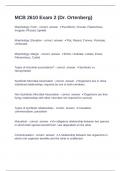-
1. Exam (elaborations) - Guest lecture questions with complete solution 2024/2025
-
2. Exam (elaborations) - Mcb 2610 chapter 6 question and answers rated a+ 2024/2025
-
3. Exam (elaborations) - Mcb 2610 chapter 7 part 1 question and answers 100% correct 2024/2025
-
4. Exam (elaborations) - Mcb 2610 exam 1 question and answers already passed 2024/2025
-
5. Exam (elaborations) - Mcb 2610 exam 1 question and answers verified to pass 2024/2025
-
6. Exam (elaborations) - Mcb 2610 exam 1 question and answers correctly solved 2024/2025
-
7. Exam (elaborations) - Mcb 2610 exam 1 questions wth complete solution 2024/2025
-
8. Exam (elaborations) - Mcb 2610 exam 1 question and answers rated a+ 2024/2025
-
9. Exam (elaborations) - Mcb 2610 exam 1 chapter 1 question and answers 100% correct 2024/2025
-
10. Exam (elaborations) - Mcb 2610 exam 1 question and answers already passed 2024/2025
-
11. Exam (elaborations) - Mcb 2610 exam 1 question and answers correctly solved 2024/2025
-
12. Exam (elaborations) - Mcb 2610 exam 1 questions with complete solution 2024/2025
-
13. Exam (elaborations) - Mcb 2610 exam 1 question and answers rated a+ 2024/2025
-
14. Exam (elaborations) - Mcb 2610 exam 1 microbe minutes question and answers 100% correct
-
15. Exam (elaborations) - Mcb 2610 exam 1 microscopy question and answers already passed 2024/2025
-
16. Exam (elaborations) - Mcb 2610 exam 1 questions and answers verified to pass 2024/2025
-
17. Exam (elaborations) - Mcb 2610 exam 1 question and answers correctly solved 2024/2025
-
18. Exam (elaborations) - Mcb 2610 exam 2 questions with complete solution 2024/2025
-
19. Exam (elaborations) - Mcb 2610 exam 2 question and answers rated a+ 2024/2025
-
20. Exam (elaborations) - Mcb 2610 exam 2 question and answers already passed 2024/2025
-
21. Exam (elaborations) - Mcb 2610 exam 2 guest lecture question and answers already passed 2024/2025
-
22. Exam (elaborations) - Mcb 2610 exam 2 question and answers verified to pass 2024/2025
-
23. Exam (elaborations) - Mcb 2610 exam 2 question and answers verified to pass 2024/2025
-
24. Exam (elaborations) - Mcb 2610 exam 2 question and answers verified to pass 2024/2025
-
25. Exam (elaborations) - Mcb 2610 exam 3 question and answers correctly solved 2024/2025
-
26. Exam (elaborations) - Mcb 2610 exam 3 questions with complete solution 2024/2025
-
27. Exam (elaborations) - Mcb 2610 exam 3 question and answers rated a+ 2024/2025
-
28. Exam (elaborations) - Mcb 2610 exam 3 question and answers 100% correct 2024/2025
-
29. Exam (elaborations) - Mcb 2610 exam 4 microminutes question and answers already passed 2024/2025
-
30. Exam (elaborations) - Mcb 2610 exam 4 question and answers verified to pass 2024/2025
-
31. Exam (elaborations) - Mcb 2610 exam question and answers correctly solved 2024/2025
-
32. Exam (elaborations) - Mcb 2610 final questions with complete with complete solution 2024/2025
-
33. Exam (elaborations) - Mcb 2610 lab 1 question and answers rated a+ 2024/2025
-
34. Exam (elaborations) - Mcb 2610 lab question and answers 2024/2025
-
35. Exam (elaborations) - Mcb 2610 lab question and answers verified to pass 2024/2025
-
36. Exam (elaborations) - Mcb 2610 lab question and answers already passed 2024/2025
-
37. Exam (elaborations) - Mcb 2610 lab question and answers correctly 2024/2025
-
38. Exam (elaborations) - Mcb 2610 lab question and answers correctly solved 2024/2025
-
39. Exam (elaborations) - Mcb 2610 lab exam 1 questions with complete solution 2024/2025
-
40. Exam (elaborations) - Mcb 2610 lab exam i questions with complete solution 2024/2025
-
41. Exam (elaborations) - Mcb 2610 lab question and answers 100% correct 2024/2025
-
42. Exam (elaborations) - Mcb 2610 lab final question and answers already passed 2024/2025
-
43. Exam (elaborations) - Mcb 2610 lab question and answers already passed 2024/2025
-
44. Exam (elaborations) - Mcb 2610 lab practical 1 question and answers verified to pass 2024/2025
-
45. Exam (elaborations) - Mcb 2610 lab practical 2 question and answers correctly solved 2024/2025
-
46. Exam (elaborations) - Mcb 2610 lab practical 3 question and answers verified to pass 2024/2025
-
47. Exam (elaborations) - Mcb 2610 lab practical questions with complete solution 2024/2025
-
48. Exam (elaborations) - Mcb 2610 lab practical question and answers already passed 2024/2025
-
49. Exam (elaborations) - Mcb 2610 lab practical question and answers verified to pass 2024/2025
-
50. Exam (elaborations) - Mcb 2610 lab practical question and answers verified to pass 2024/2025
-
51. Exam (elaborations) - Mcb 2610 lab quiz questions and answers correctly solved 2024/2025
-
52. Exam (elaborations) - Mcb 2610 lab quizzes week 2 question s with complete solution 2024/2025
-
53. Exam (elaborations) - Mcb 2610 lab questions and answers verified to pass 2024/2025
-
54. Exam (elaborations) - Mcb 2610 microbe minutes exam 1 question and answers verified to pass 2024/2025
-
55. Exam (elaborations) - Mcb 2610 microbe minutes exam 1. question and answers correctly solved 2024/2025
-
56. Exam (elaborations) - Mcb 2610 microscope exam 1 question and answers correctly solved 2024/2025
-
57. Exam (elaborations) - Mcb 2610 questions with complete solution 2024/2025
-
58. Exam (elaborations) - Uconn mcb 2610 final lab practical question and answers rated a+ 2024/2025
-
59. Exam (elaborations) - Uconn mcb 2610 question and answers 100% correct 2024/2025
-
60. Exam (elaborations) - Uconn mcb2610 exam 1 question and answers correctly solved 2024/2025
-
Show more




